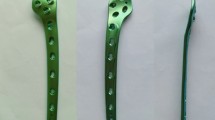Summary
We have compared the quality of intertrochanteric functional pre-bending with other techniques for varus and flexion intertrochanteric osteotomies by measuring interfragmentary compression, the tension in the angled blade-plates used and the stability of the different procedures. Intertrochanteric osteotomies with any kind of plate pre-bending gave the best results in our experimental studies. Impacting techniques gave poor primary stability and the Schneider method produced only moderate stability in flexion osteotomies. Using intertrochanteric functional prebending, varus and flexion osteotomies produced the best primary stability and the most equitable interfragmentary compression. This could be achieved with the highest precision by using a sawing gauge system at operation.
Résumé
Nous avons comparé la qualité de l'ostéotomie intertrochantérienne avec précontraite automatique avec celle des autres techniques d'ostéotomie de varisation et de flexion, comme la technique standard, la technique avec impaction et la technique de Schneider. Dans notre expérimentation nous avons mesuré la compression interfragmentaire, la tension au niveau des lamesplaques angulaires utilisées et la stabilité obtenues par chacune de ces techniques. Nous en sommes arrivés à la conclusion que les ostéotomies avec plaques préformées sont préférables. La technique avec impaction ne donne qu'une médiocre stabilité primaire et n'est pas utilisable pour corriger les inégalités de longueur des membres inférieurs. La technique de Schneider n'entraîne qu'une stabilité modérée dans les ostéotomies de flexion. En utilisant notre technique avec une plaque préformée déterminant une précontrainte automatique on obtient la meilleure stabilité primaire et la compression interfragmentaire la mieux répartie. Ceci peut-être réalisé per-opératoirement avec la plus grande précision en employant un système de scies étalonnées.
Similar content being viewed by others
References
Ganz R (1989) Die Trochanterversetzung bei adduzierender (varisierender) intertrochanterer Osteotomie. Operat Orthop Traumatol 1: 211–218
Hackenbroch MH (1989) Intertrochanteric osteotomy for the treatment of coxarthrosis. Arch Orthop Trauma Surg 108: 125–131
Kranz C, Ecke H, Ahrens U, Padberg W (1983) Einfluß der Schaftgestaltung auf das Krafteinleitungsverhalten von Hüftendoprothesen in die Kortikalis des Femurs. Eine technische und klinische Untersuchung. Biomed Technik 12: 309–315
Kummer B (1989) Die Beanspruchung des Hüftgelenkes nach hüft-und knienahen Osteotomien. Orthop Praxis 12/89: 762–771
Kummer B (1991) Die klinische Relevanz biomechanischer Analysen der Hüftregion. Z Orthop 129: 285–294
Matzen PF, Paul M (1983). Intertrochantere varisierende Osteotomie ohne Keilentnahme. Zbl Chirurgie 108: 47–49
Müller ME, Allgöwer M, Schneider R, Willenegger H (1977) Manual der Osteosynthese. 2. Aufl. Springer, Berlin Heidelberg New York
Müller ME, Krushell RJ (1983) Intertrochanteric osteotomy. In: McCollister Evarts C. Surgery of the musculoskeletal system. 2nd ed, Curchill Livingstone, New York Edinburgh London Melbourne
Perren SM, Huggler A, Russenberger M, Allgöwer M, Mathys R, Schenk R, Willenegger H, Müller ME (1969) The reaction of cortical bone to compression. Acta Orthop Scand Suppl 125: 19–28
Savvidis E, Löer F, Barden B (1990) Untersuchungen zum Festigkeitsverhalten pertrochanterer Frakturen nach Anwendung verschiedener Osteosynthesetechniken unter besonderer Berücksichtigung der Torsionsbelastung am proximalen Femur. Z Orthop 128: 661–667
Schmidt J (1991) Operative procedure using the improved osteosynthesis technique for intertrochanteric osteotomies — Preliminary report. Arch Orthop Trauma Surg 110: 257–259
Schmidt J, Kranz C, Dau A (1990) Optimierung der dynamischen Kompression bei der Winkelplattenosteosynthese durch statische interfragmentere Kompression — experimentelle Ergebnisse. Z. Orthop 128: 675–680
Schneider PG (1967) Fragmentfixierung bei der Imhäuser-Osteotomie der Epiphysenlösung mit modifizierter AO-Platte. Verh Dtsch Orthop Ges 54: 384–386
Author information
Authors and Affiliations
Rights and permissions
About this article
Cite this article
Schmidt, J., Dau, A. The primary stability of intertrochanteric osteotomies. International Orthopaedics 18, 102–108 (1994). https://doi.org/10.1007/BF02484419
Accepted:
Issue Date:
DOI: https://doi.org/10.1007/BF02484419




